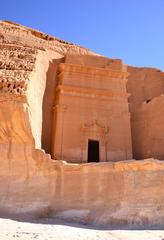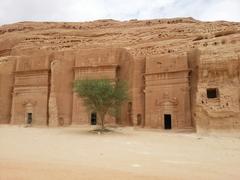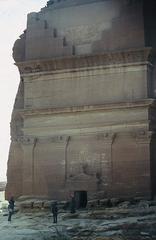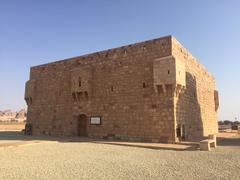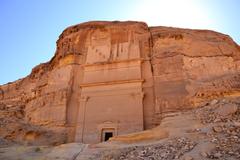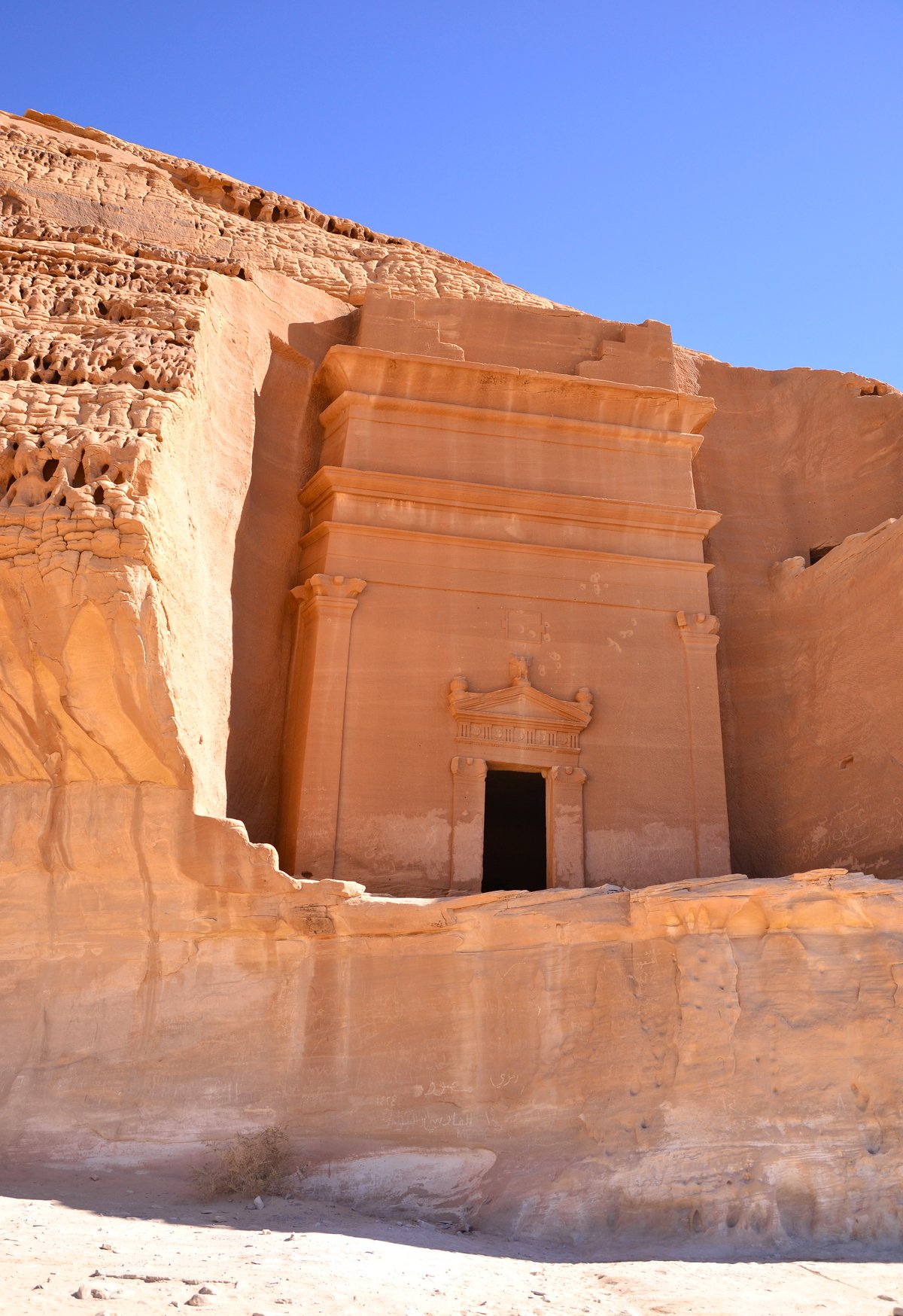
Qasr Albint Visiting Hours, Tickets, and Medina Historical Sites Guide
Date: 14/06/2025
Introduction
Qasr Albint, one of the most iconic clusters of Nabataean tombs within the UNESCO World Heritage Site of Hegra (Mada’in Saleh), stands as a testament to the artistry, engineering, and cultural sophistication of the ancient Nabataean civilization. Located in the Medina Province of Saudi Arabia, Hegra was a crucial nexus along the incense and spice trade routes, flourishing between the 1st century BCE and 1st century CE. The Qasr Albint Group, with its monumental rock-cut façades, elaborate inscriptions, and distinctive architectural features, offers visitors a window into the spiritual, social, and economic life of the Nabataeans (The Archaeologist; World Heritage Site; Saudi Archaeology).
This guide provides a comprehensive overview of Qasr Albint’s historical and architectural context, practical visitor information, travel tips, and recommendations for exploring the wider Medina historical sites. Whether you are a history enthusiast, architecture aficionado, or cultural traveler, this resource will help you plan a meaningful and memorable visit.
Contents
- Introduction
- Historical Context: The Nabataeans and Hegra
- The Qasr Albint Group: Architecture and Inscriptions
- Visiting Qasr Albint: Hours, Tickets, and Tours
- Site Navigation and Facilities
- Travel Tips and Cultural Etiquette
- Nearby Attractions in Medina Province
- Frequently Asked Questions
- Summary and Recommendations
- Sources and Further Reading
Historical Context: The Nabataeans and Hegra
Hegra (Mada’in Saleh), situated in northwestern Saudi Arabia, was the southernmost major city of the Nabataean Kingdom. The Nabataeans, originally nomadic Arab traders, established Hegra as a strategic trading outpost, connecting Arabia’s southern incense and spice routes with the Mediterranean world (The Archaeologist).
During the reign of King Aretas IV (9 BCE–40 CE), the Nabataean Kingdom reached its zenith. The Qasr Albint Group, carved during this prosperous era, reflects the wealth, cosmopolitanism, and religious beliefs of its creators. The site’s rock-cut tombs, sanctuaries, and inscriptions offer insight into Nabataean funerary customs and their syncretic blend of Arabian, Greco-Roman, and Mesopotamian influences (Saudi Archaeology).
The Qasr Albint Group: Architecture and Inscriptions
Monumental Tombs and Façades
Qasr al-Bint, meaning “Palace of the Daughter” or “Maiden’s Palace,” is the largest and most prominent tomb in Hegra, standing 16 meters high. Its impressive façade features classical Nabataean motifs: crowstep cornices, pilasters, and a grand raised portal. An inscription above the entrance precisely dates the tomb to the 40th year of King Aretas IV’s reign (circa 31 CE) and identifies its owner (The Archaeologist).
The Qasr Albint Group comprises adjacent tombs carved into golden Quweira sandstone. These tombs exhibit uniform architectural styles, with decorative elements inspired by Hellenistic, Roman, and Egyptian traditions, reflecting the Nabataeans’ extensive trade connections. Interior burial niches and Nabataean inscriptions provide further context on the tombs’ social and familial significance (Madain Project).
Broader Necropolis
The Qasr Albint Group is part of a larger necropolis containing over 100 monumental tombs, many with dated inscriptions. Area C, for instance, features 19 tombs dated from 16 to 61 CE, illustrating sustained funerary activity during Hegra’s peak (World Heritage Site).
Visiting Qasr Albint: Hours, Tickets, and Tours
Visiting Hours
- Open daily: 8:00 AM to 5:00 PM (last entry at 4:30 PM).
- Seasonal variations: Check the official AlUla tourism website or AlUla Visitor Center for up-to-date schedules, especially during national holidays or special events.
Entry Requirements & Tickets
- Saudi eVisa: International visitors must secure a Saudi eVisa prior to arrival, available online for eligible countries (Saudi eVisa Portal).
- Tickets:
- Purchase online or at the AlUla Visitor Center.
- As of 2025, prices range from 95–120 SAR ($25–$32 USD) per person, including shuttle transport and guided tour.
- Discounts available for children, students, and seniors (World Heritage Site).
Guided Tours
- Mandatory: All visits to Qasr Albint are as part of organized guided tours to protect the site.
- Languages: Tours are offered in Arabic and English.
- Duration: 2–3 hours, covering major tomb groups and key highlights.
- Transportation: Shuttle buses or 4WD vehicles take visitors from the AlUla Visitor Center to the tomb clusters. Private vehicles are not permitted inside the archaeological zone.
Site Navigation and Facilities
- Hop-On Hop-Off Buses: Stop at major tomb groups, allowing flexible exploration.
- Walking: Be prepared for uneven, sandy terrain; sturdy shoes are recommended.
- Accessibility: The site has limited wheelchair access due to its natural landscape.
- Visitor Center: Offers ticketing, refreshments (water, pomegranate juice), restrooms, and a gift shop.
- Rest Areas: Shaded areas are available at the visitor center and selected stops.
Travel Tips and Cultural Etiquette
- Best Time to Visit: October to February for cooler, pleasant weather (20–30°C / 68–86°F).
- Dress Code:
- Men: Long trousers and sleeved shirts.
- Women: Modest, loose-fitting clothing covering arms and legs. Headscarves are optional, but respectful attire is expected (Destination The World).
- Safety: Protect yourself from the sun; carry water and sunscreen.
- Respect Regulations: Do not touch or enter tombs; follow your guide’s instructions; photography is encouraged, but avoid photographing people without permission.
Nearby Attractions in Medina Province
- Other Hegra Tombs: Explore clusters such as Qasr al-Farid, Jabal al-Banat, and Al Diwan.
- AlUla Old Town: Discover mudbrick architecture, local markets, and vibrant heritage sites.
- Dadan and Jabal Ikmah: Visit ancient inscriptions and archaeological remains.
- Hejaz Railway: Learn about early 20th-century Middle Eastern history.
- Medina City: Home to the Prophet’s Mosque and other significant Islamic sites.
Frequently Asked Questions
Q: What are the visiting hours for Qasr Albint?
A: Generally 8:00 AM to 5:00 PM daily; check for seasonal variations.
Q: How do I buy tickets for Qasr Albint?
A: Online via the official tourism website or at the AlUla Visitor Center.
Q: Is Qasr Albint accessible for people with disabilities?
A: Accessibility is limited due to terrain; contact guides for assistance.
Q: Are children allowed?
A: Yes, but must be supervised.
Q: Is photography allowed?
A: Yes, but respect privacy and site restrictions; drones require special permits.
Summary and Recommendations
Qasr Albint offers an unparalleled glimpse into the Nabataean civilization’s architectural prowess, religious beliefs, and trade-driven prosperity. Its remarkable preservation and setting within the broader Hegra necropolis make it a highlight of Saudi Arabia’s heritage tourism. Visitors are encouraged to plan ahead, respect site regulations, and take advantage of guided tours for a richer experience. The proximity to AlUla and Medina further enhances your journey, presenting a spectrum of historical and cultural attractions.
For the most up-to-date information on visiting hours, tickets, and tour availability, consult the official Saudi tourism platforms and consider using digital tools like the Audiala app.
Sources and Further Reading
- Historical Background and Visitor Guide to Qasr Albint Group at Hegra, The Archaeologist
- Explore Qasr al-Bint, Medina: Visiting Hours, Tickets & Architectural Wonders of Nabataean Heritage, Madain Project
- Cultural and Historical Significance of Qasr al-Bint, Saudi Archaeology
- Exploring Qasr Albint: Visiting Hours, Tickets, and Essential Tips for AlUla Historical Sites, World Heritage Site
